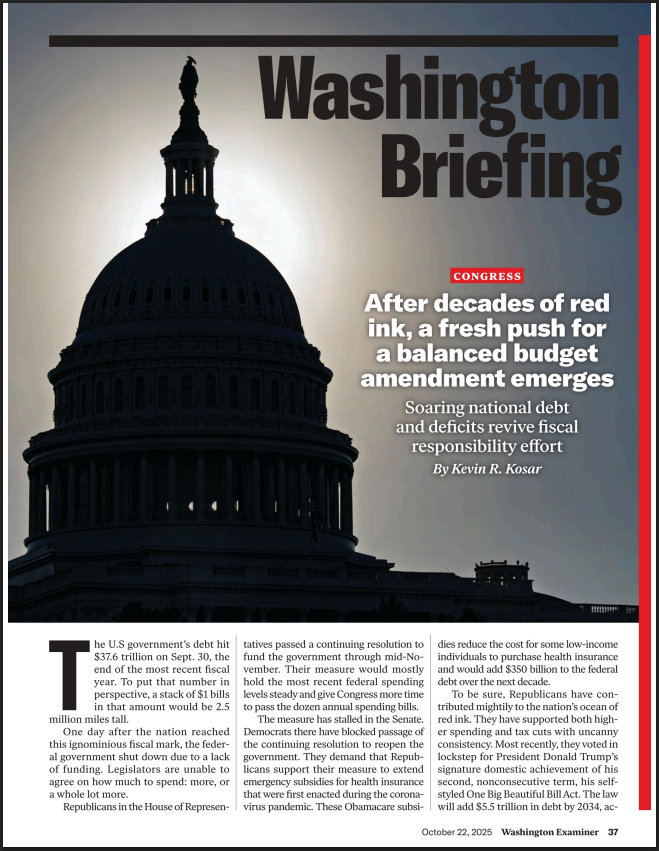
The U.S government’s debt hit $37.6 trillion on Sept. 30, the end of the most recent fiscal year. To put that number in perspective, a stack of $1 bills in that amount would be 2.5 million miles tall.
One day after the nation reached this ignominious fiscal mark, the federal government shut down due to a lack of funding. Legislators are unable to agree on how much to spend: more, or a whole lot more.
Republicans in the House of Representatives passed a continuing resolution to fund the government through mid-November. Their measure would mostly hold the most recent federal spending levels steady and give Congress more time to pass the dozen annual spending bills.
The measure has stalled in the Senate. Democrats there have blocked passage of the continuing resolution to reopen the government. They demand that Republicans support their measure to extend emergency subsidies for health insurance that were first enacted during the coronavirus pandemic. These Obamacare subsidies reduce the cost for some low-income individuals to purchase health insurance and would add $350 billion to the federal debt over the next decade.
To be sure, Republicans have contributed mightily to the nation’s ocean of red ink. They have supported both higher spending and tax cuts with uncanny consistency. Most recently, they voted in lockstep for President Donald Trump’s signature domestic achievement of his second, nonconsecutive term, his self-styled One Big Beautiful Bill Act. The law will add $5.5 trillion in debt by 2034, according to the Committee for a Responsible Federal Budget.
That neither party has shown responsible fiscal stewardship is an argument for a federal balanced budget amendment, Kurt Couchman argues in his new book, Fiscal Democracy in America. Elected officials feel strong incentives to behave as “two Santa Clauses,” as economist Jude Wanniski once put it. They try to boost their popularity and get reelected by giving people more government services while lowering their taxes. Couchman has seen this phenomenon up close, having spent the past 15 years working for legislators and Washington policy shops.
A constitutional amendment, Couchman contends, can curb elected officials from giving in to these temptations, and it might also spur them to update the half-century budget process laws that indulge fiscal recklessness.
A constitutional brake on federal spending is an idea that has been debated for nearly a century. Rep. Harold Knutson, a Minnesota Republican, introduced the first balanced budget amendment resolution in 1936. His proposal would have set a cap on the nation’s debt and forced any additional spending to be paired with new revenues. President Franklin Roosevelt and the majority of Democrats in Congress quashed the proposal, which ran contrary to their desire to try to stoke the American economy with deficit spending.
There have been hundreds of congressional resolutions advocating a balanced budget over the past half-century. That none of them passed is remarkable, not least because balanced budget policies are not uncommon outside of Washington. Various U.S. states and foreign nations have policies to curb the growth of debt. “Switzerland is the gold standard, and Sweden, Germany, and Estonia also do quite well,” Couchman told the Washington Examiner. So too Indiana and Connecticut, he added, “which have excellent balance-over-the-business-cycle, structural balance rules.”
In some instances, federal balanced budget amendments failed because they were poorly crafted. Couchman pointed out that it is not good policy to demand that the federal government balance its budget each year. That mandate would handcuff the government during an economic crisis, such as the Great Recession of 2009, or a national calamity, such as the Sept. 11 attacks.
More commonly, balanced budget amendments have been thwarted by politics. Interest groups and lobbyists who fear losing federal funds inevitably denounce balanced budget proposals. Persistent partisanship, by Democrats in particular, has also proven a hurdle. Five balanced budget amendment resolutions are pending in Congress. Each was introduced by a Republican representative. None of them has a Democratic cosponsor. This is a long-standing pattern.
And that is to say nothing of the sheer onerousness of the amendment process. The U.S. Constitution requires two-thirds of each chamber to vote for the amendment, which then must be ratified by three-fourths of the 50 state legislatures. The closest the nation has ever gotten to running this obstacle course was in 1995. The House sent a balanced budget amendment to the Senate, and there it fell one vote short of passage. Thirty-four Senate Democrats and one Republican, Oregon’s Mark Hatfield, voted nay.
Couchman hopes Republicans and Democrats alike can support his proposal, which would require Congress to balance its tax and spending policies over 10 years. Additionally, it would permit Congress to engage in deficit spending so long as two-thirds of each chamber supported doing so.
His balanced budget proposal would not force Congress to retire all the federal debt, which would necessitate severe tax increases and spending cuts. Rather, it would curb the government from adding to the national debt over the long run. Thus, the size of the national debt would decline relative to gross national product, which would decrease the peril of a debt crisis, wherein investors and foreign nations refuse to purchase U.S. bonds.
“Budgeting,” Couchman wrote, “is the hub of sound governing. Everything else revolves around it.” From his fingertips and lips to legislators’ ears.
Kevin R. Kosar (@kevinrkosar) is a senior fellow at the American Enterprise Institute and edits UnderstandingCongress.org. This essay first appeared in the Washington Examiner.
Stay in the know about our news and events.